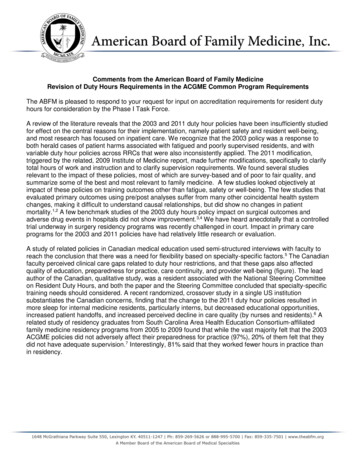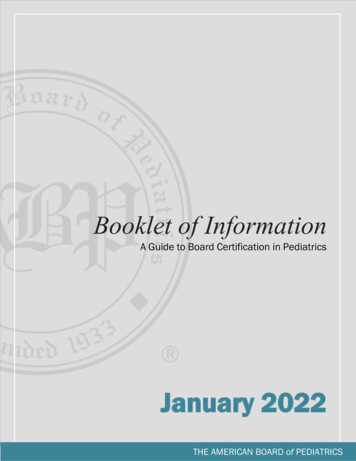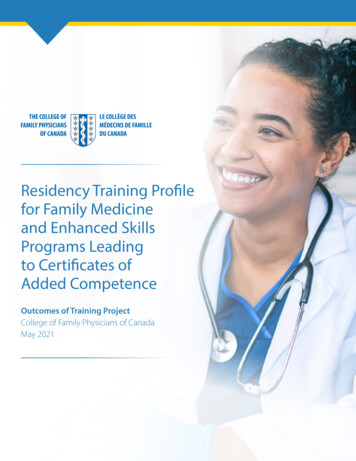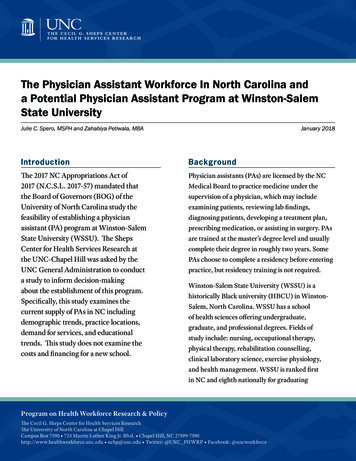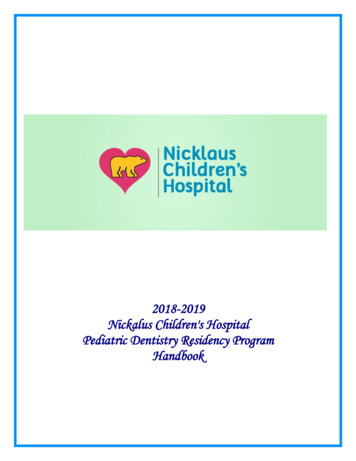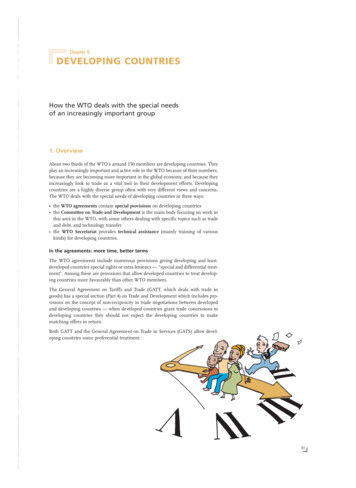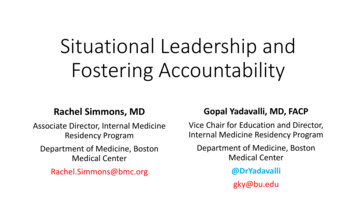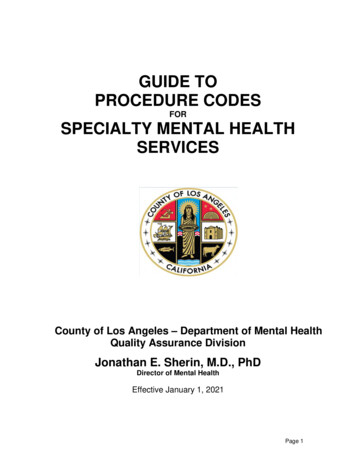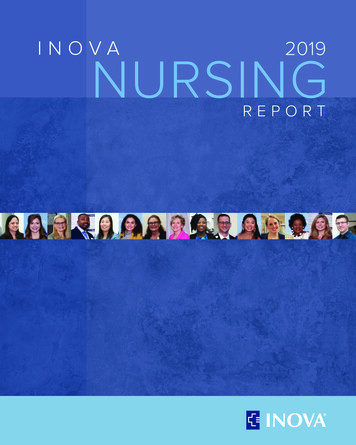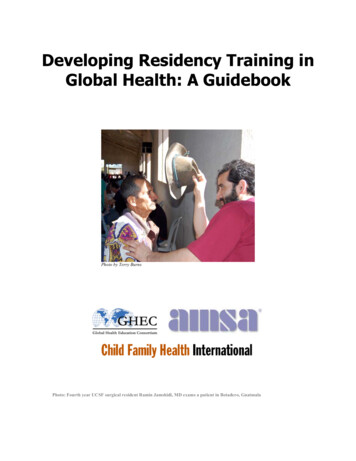
Transcription
Developing Residency Training inGlobal Health: A GuidebookPhoto by Terry BurnsPhoto: Fourth year UCSF surgical resident Ramin Jamshidi, MD exams a patient in Botadero, Guatmala
Developing Residency Training in Global Health: A GuidebookTable of ContentsIntroductionChapter 1Global Health Education: Brief History and Literature Review6-13Chapter 2Types of Global Health Programming14-22Chapter 3Ethics for Global Health Programming23-35Chapter 4Profiles of Existing Global Health Residency Programs36-78Chapter 5Developing Global Health Programs: Hurdles and Opportunities79-91Chapter 6Preparing Residents for Careers in Global Health92-103Chapter 7Professional Organizations and Global Health Curriculum:Suggested Guidelines for Pediatric Global Health Training104-109Resources for Teaching Global Health110-119Chapter 8Suggested Citation:Jessica Evert, Chris Stewart, Kevin Chan, Melanie Rosenberg, Tom Hall, andothers. Developing Residency Training in Global Health: A Guidebook. SanFrancisco: Global Health Education Consortium, 2008. 119 pp.2
Authors:Jessica Evert MD, Department of Family and Community Medicine, University ofCalifornia, San FranciscoChris Stewart, MD, MA, Assistant Clinical Professor, Department of Pediatrics,University of California at San FranciscoKevin Chan, MD, MPH, Assistant Professor, The Hospital for Sick Children and Fellow,Munk Centre for International Studies, University of TorontoMelanie Rosenberg, MD, Pediatric Hospitalist, Children’s National Medical CenterThomas Hall, MD, DrPH, Lecturer, Department of Epidemiology and Biostatistics,University of California at San FranciscoContributors:Evaleen Jones MD, President, Child and Family Health International, AssociateProfessor, Stanford University School of MedicineScott Loeliger MS MD, Director, Mark Stinson Fellowship in Underserved and GlobalHealth, Contra Costa Family Practice ResidencyKari Yacisin, Medical Student, Wake Forest University School of MedicineRegina Crawford Windsor, Master's of Public Health Student, University of Alabama atBirminghamLaura Warner, Medical Student, Rush Medical College3
Acknowledgments:Thank you for the editing efforts ofChris Stewart, MDAssistant Clinical Professor of PediatricsUniversity of California, San FranciscoDirector of Global Health Scholars ProgramThuy Bui, MDAssistant Professor of MedicineUniversity of PittsburghGlobal Health Residency Track DirectorFlora TengMedical StudentUniversity of British ColumbiaThanks to the sponsors of this project: Global Health Education Consortium, AmericanMedical Student Association, and Child and Family Health International4
INTRODUCTIONJessica Evert MD, Department of Family and Community Medicine, University ofCalifornia, San FranciscoMelanie Rosenberg, MD, Pediatric Hospitalist, Children’s National Medical CenterThe quest to improve global health represents a challenge ofmonumental proportions: the problems seem so enormous, theobstacles so great, and success so elusive. On the other handit is difficult to imagine a pursuit more closely aligned with theprofessional values and visceral instincts of most physicians.Many young doctors enter medicine with a passionate interest inglobal health; our challenge is to nurture this commitment andencourage its expression.1Globalization is taking hold of all sectors of society. Not surprisingly, many residencyapplicants are interested in global health training opportunities during their graduatemedical education. Meanwhile, residency programs grapple with the challenges ofestablishing and expanding global health programming. The past decade has witnessed arise in number of non-profit organizations dedicated to global health exposure for futurephysicians. Child and Family Health International, Doctors for Global Health, andCommunity for Children are a few examples. In addition, interest has increased withinspecialty societies, leading to the establishment of international subcommittees andseminars, such as the annual International Family Medicine Development Workshop andthe International Child Health Section of the American Academy of Pediatrics. Themission of the Global Health Education Consortium is to support and augment theseeducational activities.This is an exciting time for global health program development. As with any programintroduction or expansion, the challenges are many. This guidebook tries to navigate themaze of global health education, provide examples of global health residency training,and identify resources for developing and improving programs. In the midst of thisendeavor, we must keep in mind the founding oath of medical practice. Just asphysicians swear to “do no harm” to their patients, we must be mindful of inadvertentharms of global health work and conscientiously try to avoid them.1. D Shaywitz and D Ausiello. “Global Health: A Chance for Western Physicians toGive and Receive.” The American Journal of Medicine. 2002;113(4)354-7.A PDF version of this document is available at www.globalhealth-ec.org under“Resources”.5
CHAPTER 1GLOBAL HEALTH EDUCATION: HISTORY AND LITERATURE REVIEWJessica Evert MD, Department of Family and Community Medicine, University ofCalifornia, San FranciscoMelanie Rosenberg, MD, Pediatric Hospitalist, Children’s National Medical CenterA Brief History*Although the idea that medicine and health transcend geographic boundaries is not new,it is taking a long time for it to be fully integrated into U.S. medical education andpractice. Over the last 20 years, globalization of all sectors of society, includingbusiness, media and education, has been expedited and facilitated by theinternet/computer revolution. However, the discipline of international health (or as it isnow being termed, “global health”) in its current form has evolved over the last 150years.The roots of international health can be traced to the cholera outbreak of the mid-1800s.This disease crisis prompted physicians and politicians to convene the first InternationalSanitary Conference in 1851. Successive conferences focused on the “germ de jour,”such as yellow fever and bubonic plague, for the remainder of the 19th century. Theseconferences took place annually until 1938, eventually becoming meetings in which theleading discoveries in medicine were presented and served as a vehicle for thedevelopment of shared medical diction.In 1902 hemispheric collaboration to deal with yellow fever led to the creation of the PanAmerican Sanitary Bureau (now called the Pan American Health Organization), whichsoon became a model for transnational information sharing and health promotion.Following World War I, organizations from different corners of the globe (the leadingone being the League of Nations Health Committee) expanded international health from afocus on infectious disease to a discipline addressing maternal and infant health,nutrition, housing, physical education, drug trafficking, and occupational health.The brutalities of World War II Nazi concentration camps gave rise to a new degree ofhumanism that led to unprecedented cooperation as the world vowed to prevent repetitionof such suffering. As is evident, many of the early events leading up to modern-dayinternational health were focused on health crises in the Americas and Europe. In 1948,the World Health Organization (WHO) was created out of the UN’s desire to have asingle global entity charged with fostering cooperation and collaboration among membercountries to address health problems. The mission of WHO embodied a new concept ofhealth: it was not merely the absence of disease but the promotion, attainment, andmaintenance of physical, mental, and social well-being.In 1948 the first Student International Clinical Conference brought together medicalstudents throughout Europe. In 1951, this conference evolved into the InternationalFederation of Medical Students’ Associations with the stated objective of “studying and6
promoting the interests of medical student co-operation on a purely professional basis,and promoting activities in the field of student health and student relief.” This missionwas soon expanded to include medical student cooperation to improving the health of allpopulations. In 1947, doctors from 27 countries met in Paris and created the WorldMedical Association, whose objective is “to serve humanity by endeavoring to achievethe highest international standards in Medical Education, Medical Science, Medical Artand Medical Ethics, and Health Care for all people in the world.”WHO’s failure to eradicate malaria (after a significant victory over smallpox) revealedthe interrelationship of health and infrastructure, culture, politics and economic stability.In addition, it demonstrated the imperative that health campaigns be culturally-sensitiveand discredited the notion of magic bullets for the world’s disease burdens. MedecinsSans Frontieres (Doctors Without Borders) was created in 1971 by physicians dissatisfiedwith the inadequate efforts of WHO and the International Red Cross to address structuraland political barriers that led to health crises. In 1977 WHO shifted from a diseasespecific to a health-for-all approach.The increasing focus on international health is evident in several large U.S.A.organizations. The International Health Medical Education Consortium (now called theGlobal Health Education Consortium), created in 1991, now has a membership ofapproximately 80 medical schools in the U.S.A. and Canada and aims to fosterinternational health education for medical students. The American Medical Associationopened its Office of International Medicine in 1978, the U.S.A. chapter of InternationalFederation of Medical Students’ Association (IFMSA) was started in 1998 and the GlobalHealth Action Committee of the American Medical Student Association in 1997. Today,many specialty professional organizations have global health subcommittees.Today, we are increasingly aware that health is determined by interrelated medical,political, economic, educational, and environmental factors. Consequently, the future ofworld health requires partnerships between nations, health care professionals, medicalresearchers, public health specialists, corporations, and individuals. Currently, theeconomic, human, and environmental consequences of the health disparities in the worldare being elucidated. For example, in 2001 the WHO Macroeconomic Commission onHealth put forth three core findings:1. The massive amount of disease burden in the world’s poorest nations poses ahuge threat to global wealth and security.2. Millions of impoverished people around the world die of preventable andtreatable infectious diseases because they lack access to basic medical care andsanitation.3. We have the ability and technology to save millions of lives each year if onlythe wealthier nations would help provide poorer countries with such health care1and services.These principles sound simple and straightforward, but their implementation is complexand expensive. We have reached a point in the history of international medicine wheretrained professional and technical personnel from many fields are cooperating to meet the7
multifaceted challenges to world health. Each field is training individuals equipped toparticipate in these efforts. Just as medicine is training doctors who specialize ininternational health, law is training lawyers who specialize in international law. Medicaleducators around the world are trying to identify skills sets necessary for collaborationand to find ways to cultivate them among interested trainees.Literature Review of Global Health Graduate Medical EducationBackground.-- An article in the November 1969 issue of the Journal of the AmericanMedical Association reported, “every U.S.A. medical school is involved in suchinternational activities as faculty travel for study, research and teaching, clinical trainingfor foreign graduates, and medical student study overseas.a recent self-survey by CaseWestern Reserve medical students indicated that 78% of the first-year class and 85% ofthe second-year class were interested in studying or working abroad at sometime in their2medical school careers.” The article went on to report that 600 American medicalstudents went abroad during the academic year 1966-1967. This interest in global healthcontinues today. Results of recent surveys by the Association of American MedicalColleges show that the proportion of American medical students taking an internationalelective during medical school has increased significantly over the last decade, from3under 15% in 1998 to almost 30% in 2006. More and more medical schools have begunoffering formal training in global health. As this training increases, so will the demandfor continued and more specialized training during residency.Effects of International Electives on Students and Residents: Public HealthKnowledge, Clinical Skills, and Cultural Sensitivity.--Efforts have been made toinvestigate the benefits of such international electives on medical students and residents.One study showed that medical students who participated in a 3-6-week internationalprogram scored significantly higher in the preventive medicine/public health sections ofthe USMLE board exam than a control group.4 In another study, medical studentparticipants said their international experience sharpened awareness of the importance ofpublic health and patient education.5 Seventy-eight percent of the students also reporteda heightened awareness of cost issues and financial barriers to patient care. All studentsin this group also reported that they appreciated the utility of a history and physicalexamination over the use of diagnostic tests. In a study of medical students and residentswho participated in international health electives, attitudes toward the importance ofdoctor-patient communication, use of symbolism by patients, public health interventions,and community health programs were more positive after than before their experience
obstacles so great, and success so elusive. On the other hand . the International Child Health Section of the American Academy of Pediatrics. The mission of the Global Health Education Consortium is to support and augment these educational activities. This is an exciting time for global health program development. As with any program introduction or expansion, the challenges are many. This .
